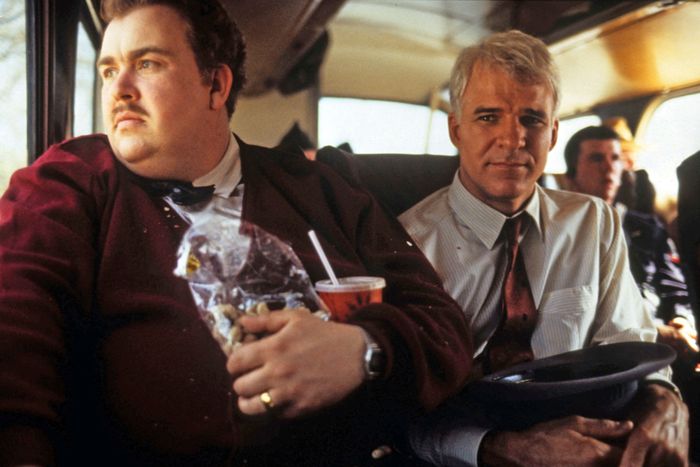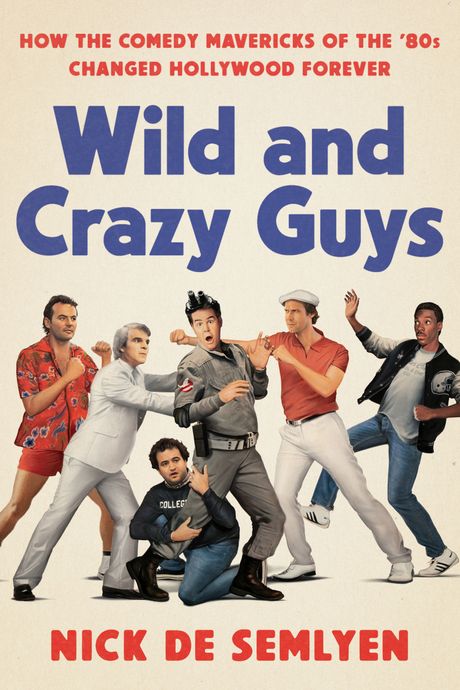
After producing anarchic and explicitly boundary-pushing comedy in the ’70s — early Saturday Night Live, Animal House, the National Lampoon — many of the era’s biggest breakout stars established themselves as the definers of 1980s mainstream comedy films. They refined their styles, toned down their impulses, and appeared in (and often wrote) the decade’s most popular if not definitive movies like Caddyshack, Ghostbusters, and Strange Brew among others. In his new book Wild and Crazy Guys: How the Comedy Mavericks of the ’80s Changed Hollywood Forever, author Nick de Semlyen explores the stories behind those movies and the dudes who made them, including Chevy Chase, Bill Murray, Rick Moranis, precocious SNL-to-Beverly Hills Cop upstart Eddie Murphy, and Steve Martin.
Maybe the most underrated and low-key comedy icon of the ’80s: SCTV breakout star John Candy. Usually playing nice, friendly guys and gregarious working-class men in Stripes and Spaceballs, he probably turned out his funniest (and most heartbreaking) work in John Hughes’s 1987 road movie Planes, Trains and Automobiles. Here’s an excerpt from Wild and Crazy Guys on the making of that film.
As a young copywriter in the advertising world, John Hughes had once been dispatched for a one-day business trip from Chicago to New York. It should have been simple. But five days later, he staggered into his house, almost destroyed by a snafu-packed odyssey that had seen him diverted to Phoenix. Hughes turned the trip over in his mind for years, embellishing it and making it even more hellish, finally setting the tale down on paper (with the route reversed) as Planes, Trains and Automobiles.
The story wasn’t just a procession of mishaps, though. It was a touching portrayal of a friendship slowly gestating between two polar opposites: control-freak executive Neal (Hughes’s avatar) and a slobbish, jolly, but deep-down-sad salesman of shower-curtain rings called Del.
Although surprised by the thickness of the script — comedies usually clock in at around 90 pages — Steve Martin jumped at the chance to play Neal. “At that point in my career, that was the direction I was headed for — more emotional roles,” he later said. “So this was a real breakthrough for me.” And Candy saw a poignancy in Del to which he could relate. He and Martin had both done small, crazy cameos in Little Shop of Horrors, but here they had a chance to forge a powerful double-act, like Laurel and Hardy in reverse, with the thin one angry, the portly one guileless. When they met there was instant comic chemistry. “We’d look into each other’s eyes and it felt good together,” said Martin. “We had great timing.”
Planes, Trains and Automobiles was, aptly, a giant road trip of a production, shooting in New York, Chicago, L.A., and all over the Midwest from February to May, 1987. Also aptly, it was a race against time. Just as in the story Neal and Del are speeding across the country to get home for Thanksgiving, so, with a release date of November 25, the production was racing to get into theaters for actual Thanksgiving. Not helping matters was Hughes’s insistence on shooting every detail of his mammoth screenplay (of an extra in the back of a shot holding a shoebox with white mice in it, the director said, “I thought it’d be funny, maybe you’re watching it for the third or fourth time on cable somewhere, your mind wanders away from the main activity in the scene, and … ‘Are those mice?’”) and the fact that they had to keep relocating to find fresh snow. One actor, cast as a truck driver with a single line of dialogue, was kept on standby for so many days because of the weather that he was able to make the down payment on a house.
Martin and Candy, clad in a topcoat and parka, respectively, were freezing their butts off. But they knew they were making gold. Between takes, Candy would crack up Martin by pretending to act out a cheesy gladiator movie, moving his lips in a way that made it sound like he was dubbed. And Martin was particularly impressed by one bit of improv by his co-star: During the scene where Del reveals that his wife has died and explains that’s why he attaches himself to people, Candy added the line, “But this time I couldn’t let go.” Long after Candy’s death, Martin would get a tear in his eye remembering it.
As for the funny stuff, there was an ample amount: a driving scene where Candy gets his arms trapped and sets fire to the car; an open-air ride on the back of a truck with a half-frozen, furious dog; a Martin meltdown with so much swearing that it singlehandedly got the film slapped with an R rating. But however silly it gets, it never loses its empathy for its two heroes, culminating in a tear-jerking ending where Neal invites Del into his home. It was an ideal showcase for its two stars: Martin got to zanily flip his lid and be a solid straight man; Candy got to be a clown while revealing a raw emotional core.
In November, after Hughes finished wrestling the movie down from four and a half hours to a more commercial 92 minutes, a Planes, Trains and Automobiles press conference was held on the Paramount back lot. With Candy an hour late, trekking in from a shoot in Fresno, Martin did an impromptu stand-up set to entertain the crowd of 300 journalists, riffing on the roast-turkey banquet laid out by the studio: “We already had some of that very same turkey while we were making the movie — and we shot the film a year ago.”
Once Candy arrived, the grilling began. Martin was quizzed on his use of the word “fuck” in the film, responding, deadpan, “I only used it nineteen times.” Candy was told that he looked like a sumo wrestler by a tactless Japanese reporter, who then added, “We admire big people because we are a nation of small people … Do you plan to diet?”
Candy, who had had multiple pieces of exercise equipment moved into his hotel suite during the shoot but never used them, embarrassedly admitted, “I do eat a lot of junk food, and I think about [dieting] for health reasons.” Martin jumped in with a joke. “At one point during filming, John went down to 110 pounds, which I thought was a little excessive.”
Aside from the awkward lines of questioning at publicity events, Planes, Trains and Automobiles was a moment of glory for Candy, certainly his finest hour since Splash. He was deluged with offers, including one from Monty Python’s Graham Chapman, who flew over from England to discuss a movie he wanted to write for Candy called Ditto, about a man who falls into a photocopier and somehow duplicates himself. Chapman would die of cancer before that could come to fruition, but it was a sign of Candy’s growing international stature. Wherever he went in the world, people wanted to give him a hug.
Excerpted with permission from Wild and Crazy Guys: How the Comedy Mavericks of the ‘80s Changed Hollywood Forever © 2019 by Nick de Semlyen. Available May 28, 2019 from Crown Archetype, an imprint of Penguin Random House.


